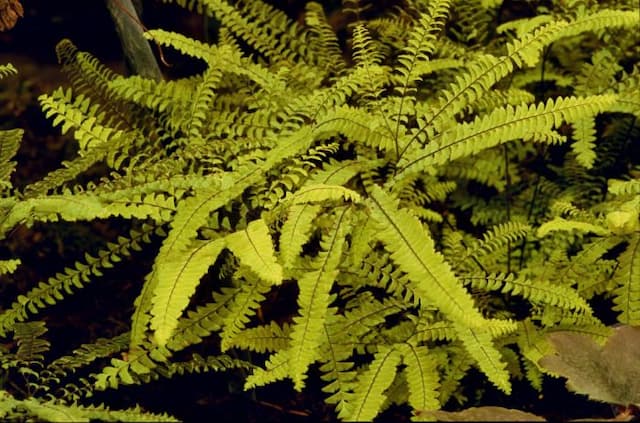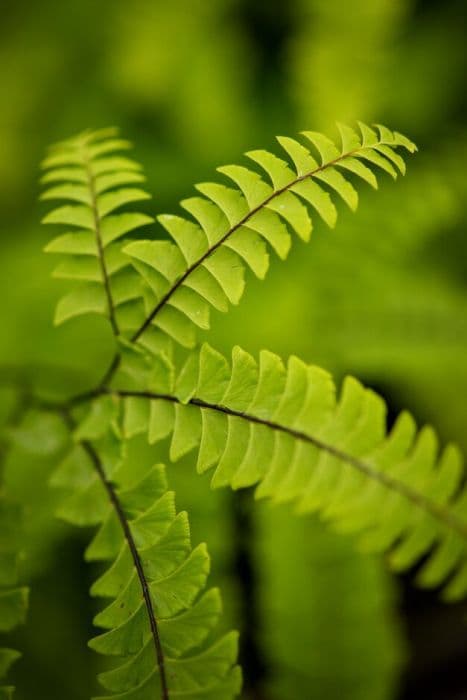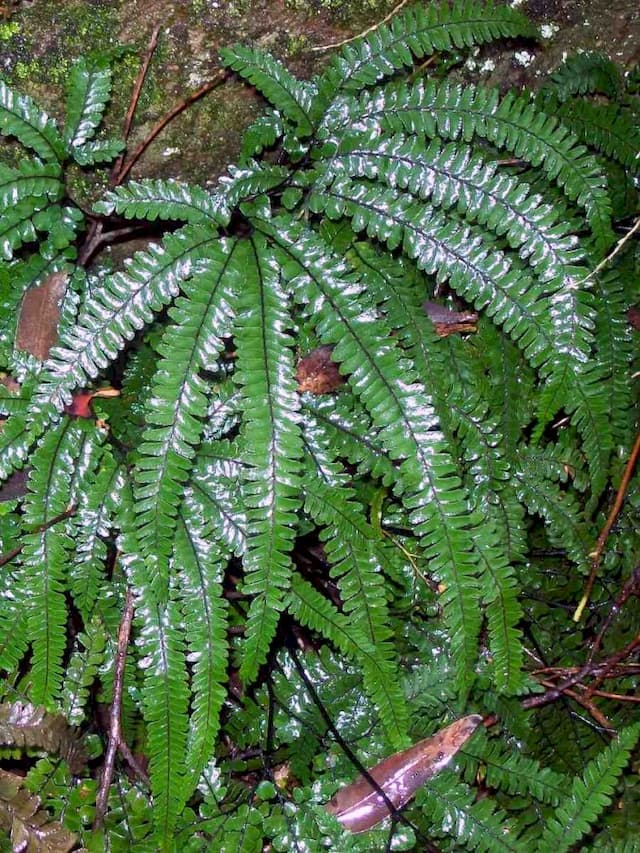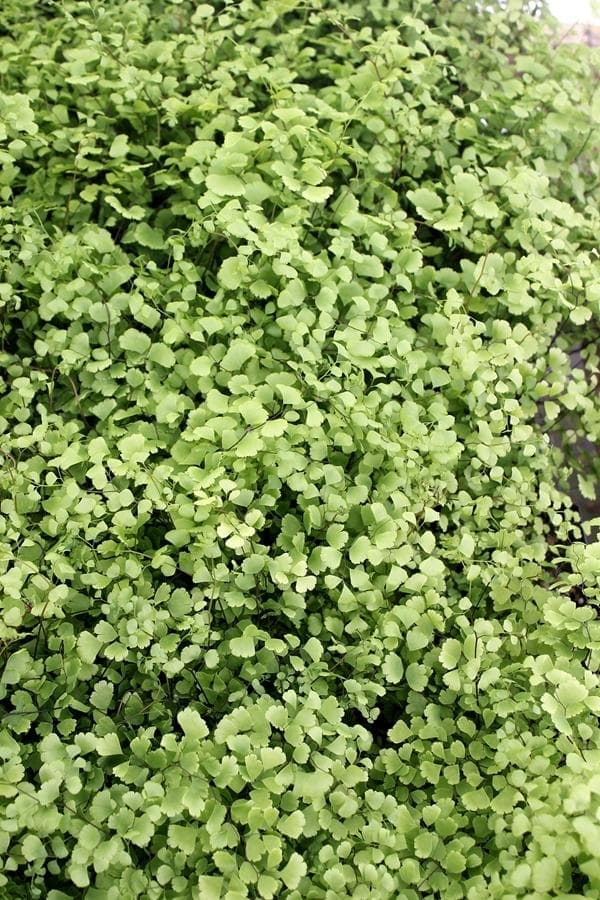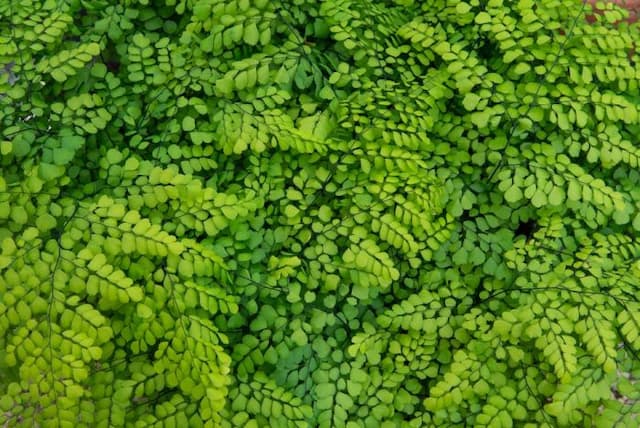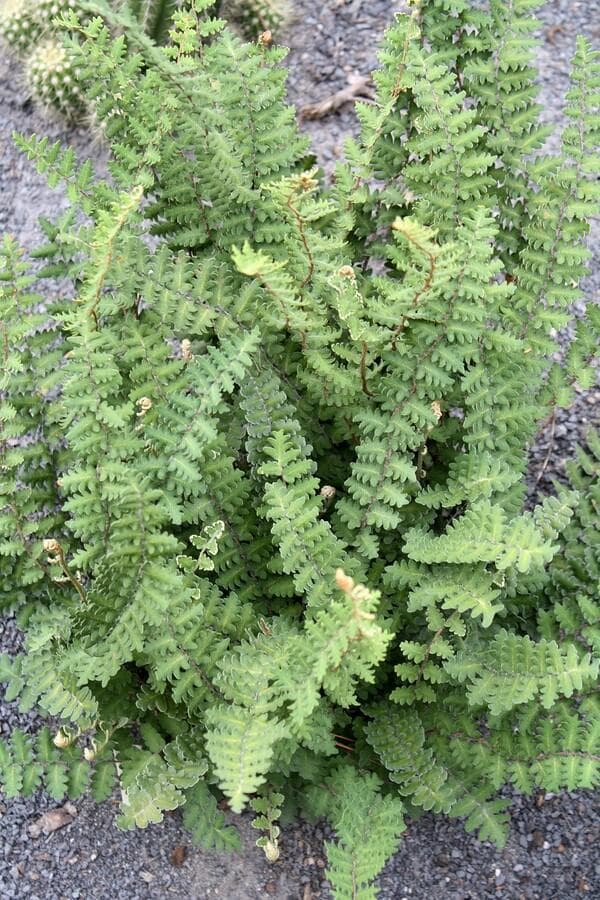Maidenhair Fern Adiantum raddianum

ABOUT
Adiantum raddianum, commonly known as the maidenhair fern, is a graceful and delicate plant that is highly sought after for its aesthetic appeal, especially in indoor and shaded garden settings. It has a distinctive appearance characterized by its fan-shaped fronds made up of small, triangular leaflets. These leaflets are soft and light green, creating a gentle, feathery texture that can add a lush appearance to any space. The fronds themselves are held aloft on shiny, black or dark brown stems that contrast beautifully with the vivid green of the leaves. The overall impression of a maidenhair fern is one of elegance and lightness, with its cascading fronds forming a fountain-like shape. This plant is popular for its air-purifying properties and is often used in terrariums, hanging baskets, and as a complement to other plants in mixed container displays.
About this plant
 Names
NamesFamily
Pteridaceae.
Synonyms
Delta Maidenhair, Maidenhair Fern, Venus Hair Fern, Southern Maidenhair, American Maidenhair.
Common names
Adiantum cuneatum, Adiantum decoratum, Adiantum drewianum, Adiantum formosum, Adiantum juglandifolium, Adiantum lunulatum, Adiantum poiretii, Adiantum raddianum var. decoratum, Adiantum raddianum var. formosum, Adiantum raddianum var. grandiceps, Adiantum raddianum var. roezlii, Adiantum raddianum var. typicum, Adiantum raddianum var. wilesianum, Adiantum rhizophorum, Adiantum ruderatum, Adiantum tenerum, Adiantum trapeziforme, Adiantum wilesianum, Choristopteris raddiana.
 Toxicity
ToxicityTo humans
The Maidenhair Fern is considered non-toxic to humans. Ingesting this plant is not known to cause serious harm or poisoning in humans, and it is generally recognized as safe to keep in homes.
To pets
The Maidenhair Fern is also considered non-toxic to pets such as cats and dogs. There should be no toxic consequences if a pet chews on or ingests parts of this plant. It is often recommended as a pet-safe houseplant.
 Characteristics
CharacteristicsLife cycle
Perennials
Foliage type
Evergreen
Color of leaves
Green
Height
1-2 feet (30-60 cm)
Spread
1-2 feet (30-60 cm)
Plant type
Fern
Hardiness zones
10-11
Native area
South America
Benefits
 General Benefits
General Benefits- Increases humidity: Adiantum raddianum, commonly known as maidenhair fern, transpires water vapor, which increases indoor humidity levels that can benefit both people and other houseplants.
- Enhances aesthetics: The delicate, fan-shaped leaves and arching fronds of the maidenhair fern add a touch of elegance and beauty to indoor spaces.
- Easy to propagate: Maidenhair fern can be easily propagated through division, making it simple to create new plants for yourself or to share with others.
- Reduces stress: Studies have shown that the presence of plants in indoor spaces can reduce stress and create a calming atmosphere, which may be attributed to the lush green appearance of this fern.
- Non-toxic to pets: Maidenhair fern is safe for cats and dogs, making it a worry-free choice for pet owners who want to keep live plants in their home.
 Medical Properties
Medical PropertiesThis plant is not used for medical purposes.
 Air-purifying Qualities
Air-purifying QualitiesThis plant is not specifically known for air purifying qualities.
 Other Uses
Other Uses- Decor for terrariums: Maidenhair fern is often used to create lush green backgrounds inside terrariums due to their fine foliage and the ease at which they can grow in high-humidity environments.
- Ornamental tattoos: Illustrations of Maidenhair fern are popular in tattoo art, symbolizing new beginnings or the idea of delicateness.
- Art subjects: The intricate pattern of its leaves makes Maidenhair fern a favored subject for botanical illustrators and photographers.
- Floristry: Maidenhair fern is used in flower arrangements to add a delicate texture and vibrant green color, providing a contrast to more colorful flowers.
- Wedding bouquets: Due to their dainty appearance, Maidenhair ferns are often included in bridal bouquets and wedding decorations.
- Educational tool: It is used in botanical education to teach about the reproduction of ferns, due to its characteristic sori which house spores on the undersides of the fronds.
- Biophilic design: Maidenhair fern is used in biophilic design in homes and offices to bring elements of nature into living and working spaces and enhance well-being.
- Green roofs: Some architects use Maidenhair fern for planting on green roofs, where plants are partially or completely covering a roof.
- Crafts: Festive decorations and wreaths sometimes incorporate Maidenhair fern, especially in arrangements that require a soft, feathery look.
- Culinary presentation: Although not eaten, fresh or dried fronds of Maidenhair fern can be used as an elegant garnish for plating in high-end culinary settings.
Interesting Facts
 Feng Shui
Feng ShuiThe Maidenhair Fern is not used in Feng Shui practice.
 Zodiac Sign Compitability
Zodiac Sign CompitabilityThe Maidenhair Fern is not used in astrology practice.
 Plant Symbolism
Plant Symbolism- Fragility: Adiantum raddianum, commonly known as Maidenhair Fern, has delicate, feathery fronds that can easily break, symbolizing vulnerability and the need for gentle care.
- Elegance: The graceful arching fronds and fine texture of the Maidenhair Fern represent elegance and beauty.
- Secret Bond: In the language of flowers, Maidenhair Fern is said to symbolize a secret bond of love, often exchanged between lovers as a clandestine message.
- Purification: Ferns in general are believed to purify the surrounding air, and the Maidenhair Fern is no exception, making it a symbol of cleansing and renewing energy.
- New Beginnings: Its preference for moist environments and its ability to thrive in shade associate the Maidenhair Fern with growth and resilience, making it a symbol for seizing new opportunities.
 Water
WaterFor the Maidenhair Fern, ensure soil remains consistently moist but not waterlogged. Water the plant once the top inch of soil feels dry, which typically amounts to watering once every 1-2 weeks. Depending on the environmental conditions and the size of the pot, you might need to water with 8-16 ounces of water. During the growing season in spring and summer, you might find watering more frequently is necessary, whereas in winter, the watering frequency should be reduced. Allow excess water to drain away to prevent root rot.
 Light
LightMaidenhair Fern thrives in bright, indirect light. A north-facing window is ideal, or a spot that receives filtered light through a sheer curtain. Avoid direct sunlight exposure as it can scorch the delicate fronds of the plant. If the light is too low, the plant may become leggy and if it's too bright the fronds may turn yellow and dry out.
 Temperature
TemperatureThe ideal temperature range for a Maidenhair Fern is between 60-75°F. They can survive at temperatures as low as 50°F and as high as 80°F, but prolonged exposure to conditions outside the ideal range may stress the plant. Keep the fern away from drafts and sudden temperature changes to maintain a consistent environment.
 Pruning
PruningPrune the Maidenhair Fern to remove any brown or dead fronds, to maintain plant shape, and to encourage healthy new growth. This can be done as needed throughout the year but is best performed in the spring, which is the start of the plant's active growing season. Use sharp scissors to make clean cuts without tearing the delicate fronds.
 Cleaning
CleaningAs needed
 Soil
SoilMaidenhair Fern thrives in a well-draining, fertile soil mix with a pH of 6.0 to 7.0. A mixture of peat, pine bark, and perlite works well for proper drainage and aeration. Regularly test soil pH to maintain optimal conditions.
 Repotting
RepottingMaidenhair Ferns should be repotted every two years to prevent them from becoming root-bound and to refresh the soil. It's best done in the spring just as the plant resumes active growth.
 Humidity & Misting
Humidity & MistingMaidenhair Ferns require high humidity levels, ideally between 60% and 80%. Maintaining proper humidity is essential for the health of this delicate fern.
 Suitable locations
Suitable locationsIndoor
Place Maidenhair Fern in bright, indirect light and ensure high humidity.
Outdoor
Grow Maidenhair Fern in shade with shelter from wind and frosts.
Hardiness zone
10-11 USDA
 Life cycle
Life cycleThe Adiantum raddianum, commonly known as the maidenhair fern, begins its life cycle as a spore that germinates under moist, warm conditions to develop into a gametophyte, a small heart-shaped plant phase. This gametophyte then produces both sperm and eggs in specialized structures; the sperm swims to the eggs and fertilizes them, resulting in the formation of a baby fern called a sporophyte. As the sporophyte matures, it grows into the familiar fern plant with delicate, fan-shaped fronds that perform photosynthesis and gather energy for growth and development. In the reproductive stage, the underside of the fronds develops sori, clusters of sporangia where spores are produced. When the spores are mature, they are released into the environment to start the next generation if conditions are favorable. Over time, the maidenhair fern can spread and form a lush growth through vegetative propagation as well, where new plants grow directly from the rhizomes or fronds that touch the soil.
 Propogation
PropogationPropogation time
Spring to Summer
The most popular method of propagation for the Maidenhair fern (Adiantum raddianum) is through division. The best time to undertake this process is in the spring when the plant is emerging from its dormant winter period and is about to enter a phase of active growth. To propagate by division, remove the plant from its pot and gently separate the rhizomes, ensuring that each division has an adequate number of fronds and roots attached. Plant the divisions in fresh potting mix, ideally in small pots about 4 to 6 inches (10 to 15 centimeters) in diameter, and water them well. Keep the newly potted ferns in a warm, humid environment out of direct sunlight until they are established and showing signs of new growth, which can take several weeks.

